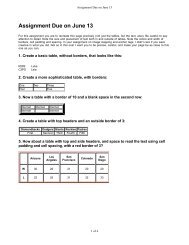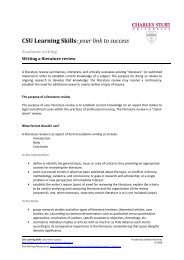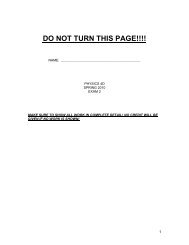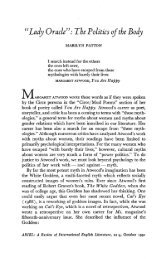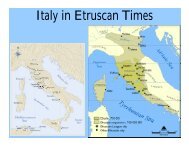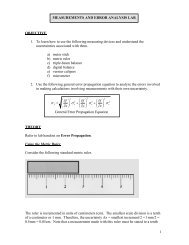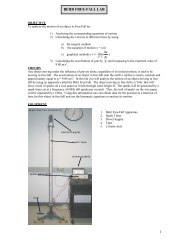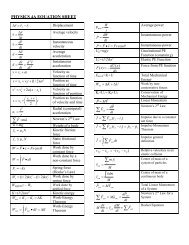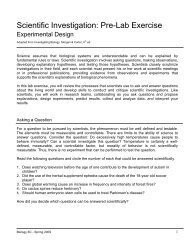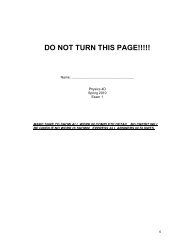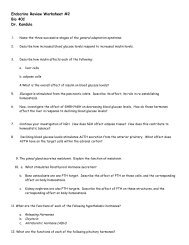Ex 24 cover sheet API 20E Multiple Test Strip - De Anza College
Ex 24 cover sheet API 20E Multiple Test Strip - De Anza College
Ex 24 cover sheet API 20E Multiple Test Strip - De Anza College
Create successful ePaper yourself
Turn your PDF publications into a flip-book with our unique Google optimized e-Paper software.
<strong>Ex</strong> # <strong>24</strong>, p 61-64<strong>API</strong> <strong>20E</strong> <strong>Multiple</strong> <strong>Test</strong> <strong>Strip</strong>Clinical Rapid Identification of Enterobacteriaceae and other Gram Negative RodsAdditional references:1. Textbooka. Ch2. Photo Atlasa. p 45-46Notes:1. Prepare a suspension of the bacteria in the salinetube: Inoculate a large colony (2-3mm diameter) ofthe bacterium (pure culture) into the 0.85% NaClsolution, making sure that the suspension ishomogenous and without clumps of floating bacteria2. Inoculate the <strong>API</strong> strip:a. Holding the strip at a slight angle up from thetable top, inoculate the bacterial suspensioninto each well with a sterile pipetteb. Touch the end of the pipette to the side of the cupule, allowing capillary action todraw the fluid into the well as you slowly squeeze the bulb. This should eliminateany bubbles forming in the wells. Each well should be filled up to the neck (seediagram)c. CIT, VP, and GEL have boxes around their names. These test wells will befilled all the way up to the top of the welld. LDC, ODC, ADH, H 2 S, and URE are filled as described in step B, but theywill then be filled up to the top with sterile mineral oil
3. Incubate the strip in its chamber:a. The bottom of the incubation chamber has small indented wells: fill it with waterjust enough to fill these indentationsb. Place the strip onto the bottom of the chamber. There should not be so muchwater that it slops onto the top of the <strong>API</strong> stripc. Place the top of the incubation chamber over the bottom, and label itd. Place the strip at 37 o C for 18-<strong>24</strong> hours4. Interpretation:a. Add the proper reagents to the compartments:I. 1 drop of Kovac's to the IND (read within a couple of minutes)II. 1 drop of Barritt's A and B to VP (a + reaction may take up to 10 minutes)III. 1 drop of FeCl3 to TDAb. Read all other tests as described (chart below) without reagentsc. Record results on the diagram handed out to you in labI. 1, 2, or 4 points for + reaction, 0 points for - reactionII. The oxidase test reaction should be negative, and is added as the last testresultd. Three test reactions are added together to give a 7-digit number, which can thenbe looked up in the codebook
READING THE <strong>API</strong> 20TESTS SUBSTRATE REACTION TESTED - RESULTS + RESULTSONPG ONPG beta-galactosidase colorless yellowADH arginine arginine dihydrolase yellow red/orangeLDC lysine lysine decarboxylase yellow red/orangeODC ornithine ornithine decarboxylase yellow red/orangeCIT citrate citrate utilization pale green/yellow blue-green/blueH2S Na thiosulfate H2S production colorless/gray black depositURE urea urea hydrolysis yellow red/orangeTDA tryptophan deaminase yellow brown-redIND tryptophan indole production yellow red (2 min.)VP Na pyruvate acetoin production colorless pink/red (10 min.)GEL charcoal gelatin gelatinase no diffusion of black black diffuseGLU glucose fermentation/oxidation blue/blue-green yellowMAN mannitol fermentation/oxidation blue/blue-green yellowINO inositol fermentation/oxidation blue/blue-green yellowSOR sorbitol fermentation/oxidation blue/blue-green yellowRHA rhamnose fermentation/oxidation blue/blue-green yellowSAC sucrose fermentation/oxidation blue/blue-green yellowMEL melibiose fermentation/oxidation blue/blue-green yellowAMY amygdalin fermentation/oxidation blue/blue-green yellowARA arabinose fermentation/oxidation blue/blue-green yellowOX oxidase oxidase colorless/yellow violetQUESTIONS:1. What is the purpose of the water in the tray?2. What is the function of the mineral oil?3. What are the advantages of this test (compared to regular biochemical tube media)?4. What are the disadvantages of this test?
Good web sites for ‘extra’ information:http://www.jlindquist.net/generalmicro/102bactid2.htmlwww.biology.ed.ac.uk/.../microbes/proteus.htmhttp://pages.usherbrooke.ca/biomedias/techniques_microbio.htmcultureno.ONPGADHLDCODCCITH2SURETDAIND8101 + – + + – – – – + – – + + – + + + + – +VPGELGLUMANINOSORRHASACMELAMYARAidentificationEscherichiacoli



